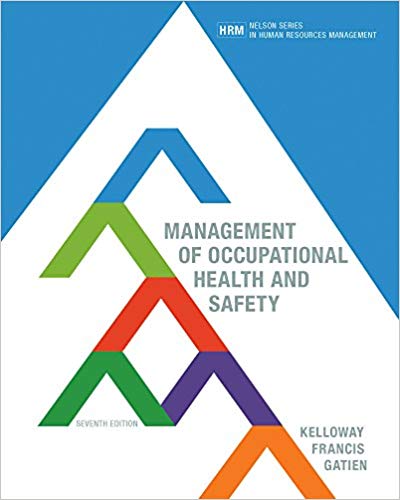Description
Management of Occupational Health and Safety Canadian 7th Edition By Kelloway – Test Bank
Chapter 3 Workers Compensation MULTICHOICE
1. After incurring a serious injury at the paper mill, Jim Larue went back to school and retrained as a pharmacy assistant. What type of workers’ compensation income support might he receive in his new job to ensure his previous income is maintained?
(A) none, he will just receive his new wage
(B) a disability pension on top of his new wages
(C) a rehabilitation benefit on top of his new wages (D) an earnings loss payment on top of his new wages Answer : (D)
2. The Workers’ Compensation Act is founded on which of the following principles? (A) collective liability for employers
(B) a system that allows for recourse to the courts
(C) compensation based on organizational earnings
(D) compensation based on who was at fault Answer : (A)
3. The Workers’ Compensation Board is responsible for making which of the following decisions? (A) whether the worker was negligent
(B) how long the rehabilitation period will be
(C) the class and rate group to which an employer belongs
(D) what type of new occupation an injured worker should pursue Answer : (C)
4. What is the first consideration in determining an employer’s WCB premiums? (A) rate group
(B) industry classification
(C) number of employees
(D) employer’s safety record Answer : (B)
5. Via Rail is Canada’s passenger railway, whereas CN Rail is a freight/cargo railway. What WCB liability do these organizations face?
(A) They both have individual liability for injuries/illnesses.
(B) They both have collective liability-the same as all other organizations. (C) Via Rail has collective liability, whereas CN has individual liability. (D) Via Rail has individual liability, whereas CN has collective liability. Answer : (A)
6. According to collective liability, employers in a class or other rate group are liable for which of the following costs?
(A) costs of net earnings
(B) costs of both accidents and occupational diseases (C) costs of just accidents
(D) costs of just occupational diseases
Answer : (B)
7. What are the three types of WCB rehabilitation? (A) vocational, physical, and retraining
(B) physical, retraining, and social
(C) vocational, physical, and social
(D) retraining, vocational, and social Answer : (C)
8. Helen worked in a fireworks factory for 25 years. After she took early retirement, her doctor told her that her long-standing health issues were due to lead poisoning from materials that are now banned. What factor will be given serious consideration in assessing her WCB claim?
(A) how old and how sick she is
(B) whether the employer told her of the risk
(C) the latency period between exposure and illness
(D) whether she is already getting a retirement pension Answer : (C)
9. Which of the following reflects how workers’ compensation boards view the social benefit of compensation?
(A) Compensation gets reluctant workers back to work.
(B) Compensation makes up for your pain and suffering.
(C) Compensation is a cost that must be tightly managed.
(D) Compensation helps you remain active in your community. Answer : (D)
10. Ivan lost an eye in an industrial accident, and is just starting a new job. How does the second injury provision work if he loses sight in the other eye?
(A) The total disability cost is borne by his current employer.
(B) The total disability cost is shared between his former and current employers.
(C) The total disability cost is borne entirely by the Workers’ Compensation Board.
(D) The total disability cost is borne by all employers in his employer’s industry rate group. Answer : (C)
11. In Canada, what is the most common basis for determining the amount of lost-time benefits? (A) 75% of net earnings
(B) 90% of net earnings
(C) 75% of average earnings
(D) 90% of average earnings Answer : (B)
12. What is the primary purpose of the WCB experience rating system? (A) to help workers identify safe versus unsafe workplaces
(B) to penalize unsafe workplaces through higher premiums
(C) to motivate employers to take a proactive approach to OH&S
(D) to provide data to the Ministry of Labour for follow-up inspections Answer : (C)
13. In general, after how many years of lower-than-annual injury costs might a Canadian employer receive a rebate on their annual assessment?
(A) after two years (B) after three years (C) after four years (D) after five years Answer : (B)

Reviews
There are no reviews yet.